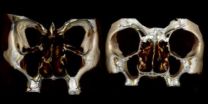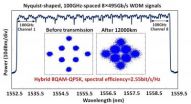(Press-News.org) Philadelphia, Pa. (March 12, 2013) – Ten years after stroke caused by a ruptured aneurysm of the brain, surviving patients have persistent difficulties in several areas affecting quality of life, reports a study in the March issue of Neurosurgery, official journal of the Congress of Neurological Surgeons. The journal is published by Lippincott Williams & Wilkins, a part of Wolters Kluwer Health.
The long-term impact of ruptured aneurysms causing subarachnoid hemorrhage (SAH) highlights the need for "survivorship care plans" comparable to those made for long-term cancer survivors, according to the report by Ann-Christin von Vogelsang, MSN, PhD, and colleagues of Karolinska University Hospital, Stockholm, Sweden.
Quality of Life Ten Years after Ruptured Aneurysm
The researchers performed a long-term follow-up study in 217 patients who had survived SAH caused by a ruptured aneurysm. Subarachnoid hemorrhage is a life-threatening type of stroke in which there is bleeding into the brain. It most commonly occurs when an aneurysm—a weak spot in one of the blood vessels supplying the brain—ruptures or breaks.
Approximately ten years after treatment for ruptured aneurysm and SAH, the patients completed a questionnaire evaluating key areas of health-related quality of life. Responses were compared with a general population sample of similar age and sex.
The aneurysm survivors were 154 women and 63 men, average age 61 years. Most underwent surgery for treatment for their ruptured aneurysm. At ten years' follow-up, 30 percent rated themselves as "fully recovered."
But compared to the general population, the SAH survivors had increased problems in four out of five dimensions of quality of life: mobility, self-care, usual activities, and anxiety/depression. (The only area that wasn't significantly worse was pain/discomfort.) On a 100-point scale, overall quality of life score averaged 71 for the aneurysm survivors, compared to 78 for the general population group.
Patients who were more disabled after their SAH had lower quality of life scores at follow-up, as did those who rated themselves as less than fully recovered. Patients with other (comorbid) health problems also had more difficulties affecting quality of life.
Survivors of SAH Need Long-Term Follow-Up and Support
Ruptured aneurysm leading to SAH is a potentially life-threatening condition. Patients who survive this serious form of stroke are at risk of physical disability and depression. Previous studies have evaluated quality of life for survivors of ruptured aneurysm, but few have looked at outcomes more than five years after the event.
One recent study suggested that patients may show continued improvement even more than a decade after SAH. Quality of life is increasingly regarded as an important factor affecting patient outcomes.
The new findings show that survivors of ruptured aneurysm have decreased quality of life and an increased rate of health problems. "The implications for health care from our study are that aneurysmal SAH patients need to be followed up and that support needs to be provided long term after the onset," Dr. von Vogelsang and colleagues write. Unrealistic expectations of recovery may be a key issue.
They believe that patients who have experienced a ruptured aneurysm might benefit from survivorship care plans, similar to those used for long-term cancer survivors. "A survivorship care plan aims to inform the patient of long-term effects, to identify psychosocial resources in their community, and to provide guidance on follow-up care, prevention, and health maintenance," Dr. von Vogelsang and coauthors add. They call for further research on how best to provide follow-up and support for SAH survivors, including studies to explore patients' expectations for recovery.
###
About Neurosurgery
Neurosurgery, the Official journal of the Congress of Neurological Surgeons, is your most complete window to the contemporary field of neurosurgery. Members of the Congress and non-member subscribers receive 3,000 pages per year packed with the very latest science, technology, and medicine, not to mention full-text online access to the world's most complete, up-to-the-minute neurosurgery resource. For professionals aware of the rapid pace of developments in the field, Neurosurgery is nothing short of indispensable.
About Lippincott Williams & Wilkins
Lippincott Williams & Wilkins (LWW) is a leading international publisher of trusted content delivered in innovative ways to practitioners, professionals and students to learn new skills, stay current on their practice, and make important decisions to improve patient care and clinical outcomes.
LWW is part of Wolters Kluwer Health, a leading global provider of information, business intelligence and point-of-care solutions for the healthcare industry. Wolters Kluwer Health is part of Wolters Kluwer, a market-leading global information services company with 2012 annual revenues of €3.6 billion ($4.6 billion). END
Ruptured aneurysm has lasting impact on quality of life
10 years after subarachnoid hemorrhage, survivors have persistent problems in key areas, reports Neurosurgery
2013-03-12
ELSE PRESS RELEASES FROM THIS DATE:
The nose's unheralded neighbor
2013-03-12
Pity the poor maxillary sinuses. Those bulbous pouches on either side of the human nose are known more for trapping mucus and causing sinus infections than anything else. They were thought to be an evolutionary relic of our distant past, with little known present value.
Yet researchers led by the University of Iowa believe the unheralded maxillary sinuses play a fortuitous, integral role in the shape and function of the human nose, even today. After studying faces of African and European origin, the team has concluded that the maxillary sinuses act as a cushion of sorts, ...
Tickling the brain with magnetic stimulation improves memory in schizophrenia
2013-03-12
Philadelphia, PA, March 12, 2013 – Cognitive impairments are disabling for individuals with schizophrenia, and no satisfactory treatments currently exist. These impairments affect a wide range of cognition, including memory, attention, verbal and motor skills, and IQ. They appear in the earliest stages of the disease and disrupt or even prevent normal day-to-day functioning.
Scientists are exploring a variety of strategies to reduce these impairments including "exercising the brain" with specially designed computer games and medications that might improve the function ...
Antibiotic-resistant strain of E. coli increasing among older adults and residents of nursing homes
2013-03-12
Antibiotic-resistant Escherichia coli (E. coli) continues to proliferate, driven largely by expansion of a strain of E. coli know as sequence type ST131. A new study points to hospitals and long-term care facilities (LTCF) as settings in which this antibiotic-resistant strain is increasingly found. The study is published in the April issue of Infection Control and Hospital Epidemiology, the journal of the Society for Healthcare Epidemiology of America.
E. coli is the most common gram-negative pathogen, causing both gastrointestinal disease and extraintestinal infections ...
Infants prefer individuals who punish those not like themselves, Yale researchers find
2013-03-12
Infants as young as nine months old prefer individuals who punish those who are not like them, and this seemingly innate mean streak grows stronger in the next five months of life, a study by researchers at Yale University has found.
Babies, like adults, prefer individuals who like the same things they do. A new study reports that they want individuals who share their tastes to be treated well by others, but want those whose tastes differ from their own to be treated badly. The study of 200 nine- and 14-month-old infants was published online in Psychological Science, ...
New distance record for 400 Gb/s data transmission
2013-03-12
As network carriers debate the next Ethernet standard—and whether transmission speeds of 400 gigabit per second or 1 terabit per second should be the norm—engineers are working on new measures to squeeze next-generation performance out of current-generation systems.
To that end, a team from AT&T has devised a new patent pending technique enabling tuning of the modulation spectral efficiency, which allows, for the first time, 400 Gb/s signals to be sent over today's 100 gigahertz-grid optical networks over ultra-long distances. Spectral efficiency is the information rate ...
Job burnout can severely compromise heart health
2013-03-12
Americans work longer hours, take fewer vacation days, and retire later than employees in other industrialized countries around the globe. With such demanding careers, it's no surprise that many experience job burnout — physical, cognitive, and emotional exhaustion that results from stress at work. Researchers have found that burnout is also associated with obesity, insomnia, and anxiety.
Now Dr. Sharon Toker of Tel Aviv University's Faculty of Management and her fellow researchers — Profs. Samuel Melamed, Shlomo Berliner, David Zeltser and Itzhak Shpira of TAU's Sackler ...
Ultra-high-speed optical communications link sets new power efficiency record
2013-03-12
Ultrafast supercomputers that operate at speeds 100 times faster than current systems are now one step closer to reality. A team of IBM researchers working on a U.S. Defense Advanced Research Projects Agency (DARPA)-funded program have found a way to transmit massive amounts of data with unprecedentedly low power consumption.
The team will describe their prototype optical link, which shatters the previous power efficiency record by half at the Optical Fiber Communication Conference and Exposition/National Fiber Optic Engineers Conference (OFC/NFOEC) in Anaheim, Calif. ...
New automated process simplifies alignment and splicing of multicore optical fibers
2013-03-12
New multicore optical fibers have many times the signal-carrying capacity of traditional single-core fibers, but their use in telecommunications has been severely restricted because of the challenge in splicing them together-- picture trying to match up and connect two separate boxes of spaghetti so that all of the noodles in each box are perfectly aligned. Now, a new splicing technique offers an automated way to do just that, with minimal losses in signal quality across the spliced sections. The method will be described at the Optical Fiber Communication Conference and ...
Penn study: Financial incentives affect prostate cancer treatment patterns
2013-03-12
Philadelphia - According to a new study by researchers at the Perelman School of Medicine at the University of Pennsylvania, prostate cancer patients of urologists who own expensive radiation equipment are more likely to receive radiation treatment in lieu of surgery than patients treated by urologists without an ownership stake in the equipment. The study, now available online in the Journal of Urology, found that integrated prostate cancer centers (IPCCs), where urology and radiation oncology practices are combined, use expensive radiation-based treatments at higher rates ...
Mystery of 'zombie worm' development unveiled
2013-03-12
How do bone-eating worms reproduce? A new study by Norio Miyamoto and colleagues from the Japan Agency for Marine-Earth Science and Technology sheds light on this question through a detailed observation of the postembryonic development and sexual maturation of Osedax worms, also known as "zombie worms." These worms typically inhabit vertebrate bones on the seafloor. The study is published online in Springer's journal Naturwissenschaften - The Science of Nature.
Osedax is Latin for "bone-devourer," which refers to how the worms bore into the bones of whale carcasses to ...
LAST 30 PRESS RELEASES:
Norbert Holtkamp appointed director of Fermi National Accelerator Laboratory
New agentic AI platform accelerates advanced optics design
Biologists discover neurons use physical signals — not electricity — to stabilize communication
Researchers discover that a hormone can access the brain by hitchhiking
University of Oklahoma researcher awarded funding to pursue AI-powered material design
Exploring how the visual system recovers following injury
Support for parents with infants at pediatric check-ups leads to better reading and math skills in elementary school
Kids’ behavioral health is a growing share of family health costs
Day & night: Cancer disrupts the brain’s natural rhythm
COVID-19 vaccination significantly reduces risk to pregnant women and baby
The role of vaccination in maternal and perinatal outcomes associated with COVID-19 in pregnancy
Mayo Clinic smartwatch system helps parents shorten and defuse children's severe tantrums early
Behavioral health spending spikes to 40% of all children’s health expenditures, nearly doubling in a decade
Digital cognitive behavioral treatment for generalized anxiety disorder
Expenditures for pediatric behavioral health care over time and estimated family financial burden
Air conditioning in nursing homes and mortality during extreme heat
The Alps to lose a record number of glaciers in the next decade
What makes a good proton conductor?
New science reporting guide published for journalists in Bulgaria
New international study reveals major survival gaps among children with cancer
New science reporting guide published for journalists in Turkey
Scientists develop a smarter mRNA therapy that knows which cells to target
Neuroanatomy-informed brain–machine hybrid intelligence for robust acoustic target detection
Eight SwRI hydrogen projects funded by ENERGYWERX
The Lundquist Institute and its start-up company Vitalex Biosciences Announces Strategic Advancement of Second-Generation fungal Vaccine VXV-01 through Phase 1 Trials under $40 Million Competitive Con
Fine particles in pollution are associated with early signs of autoimmune disease
Review article | Towards a Global Ground-Based Earth Observatory (GGBEO): Leveraging existing systems and networks
Penn and UMich create world’s smallest programmable, autonomous robots
Cleveland researchers launch first major study to address ‘hidden performance killer’ in athletes
To connect across politics, try saying what you oppose
[Press-News.org] Ruptured aneurysm has lasting impact on quality of life10 years after subarachnoid hemorrhage, survivors have persistent problems in key areas, reports Neurosurgery





